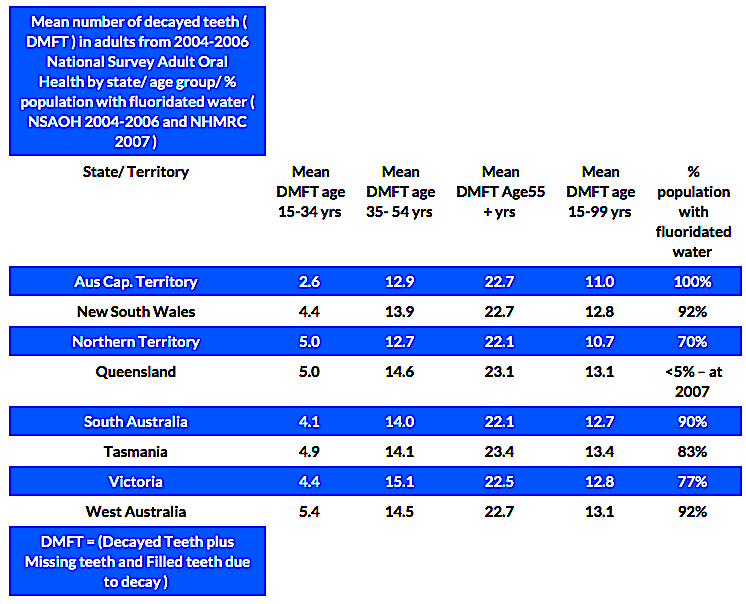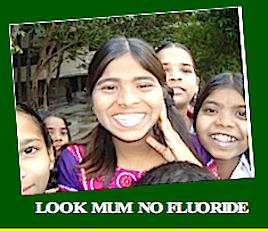FLUORIDATION SURVEYS IN AUSTRALIA
Adelaide University has had all the dental data for
over five years no report has yet been published.
Despite a long history of Australian water fluoridation, there is a dearth of national data on the measured amount of adult tooth decay in Australia. Only two national surveys measuring the oral health of Australian adults have ever been done in Australia. The first adult survey was conducted in 1987-88, the second adult survey, titled the National Survey Adult Oral Health 2004-2006 (NSAOH 2004-2006) was published in March 2007, with the 8 State and Territory reports following in August 2008.
Although one of the stated aims of the 2004-2006 National Adult Oral Health Survey was to compare the amount of tooth decay in adults to their percent of lifetime exposure to fluoridated water, as at April 2012, this has still not been reported. A formal comparison of adult tooth decay, state to state, has also not been reported by the Adelaide University NSAOH report authors.
It is possible however to generally compare the tooth decay of adults in Queensland ( less than 5% of population exposed to fluoridated water before mandatory fluoridation commenced in early 2009 ), to adults in the other Australian states where the majority of adults have been exposed to water fluoridation for 30 to 40 years or more.
Within each state and territory report there is an inconspicuous section that lists DMFT values ( DMFT = Decayed teeth, plus Missing teeth due to decay, plus Filled Teeth due to decay ). DMFT values are a measure of accumulated tooth decay experience used world-wide as a reliable index of tooth decay.
The DMFT values for adults have been collated from the 8 state and territory NSAOH reports for 4 age groups and are tabulated in this document. Graphs have also been constructed of the DMFT for each age group for each state and the percentage of the population in each state with a fluoridated water supply.
Examination of the tabulated and graphed data shows that there is very little difference in tooth decay between adults who live in Queensland with little water fluoridation ( < 5% in 2007 ) to adults who live in states and territories with the majority of public water supplies fluoridated ( 70 % to 100 % of population exposed to fluoridated water )
* QUESTION – If consuming fluoridated water for up to 40 + years
has not significantly reduced or prevented tooth decay in adults
– why are Australian water supplies still being forcibly fluoridated?
Water fluoridation is forced mass medication of the population
through their own public water supplies in an attempt to
reduce tooth decay – and it has not worked.
See below:
The 8 state and territory reports of National Adult Oral Health Survey can be
found at the Australian Research Centre Population Oral Health.
( ARCPOH ) Website at – ↓ ↓ ↓
www.adelaide.edu.au/arcpoh/
Background to the 2004-2006
National Survey Adult Oral Health
Only two national surveys measuring tooth decay in Australian adults have ever been published.
The first was titled the “National Oral Health Survey of Australia 1987-88: A report of the first national oral health survey of Australia ” (NOHSA 1987-88) and was published in 1993 by P. D Barnard and the Australian Dept. of Health, Housing, Local Government, and Community Services.
The second survey, titled the “National Survey Adult Oral Health 2004-2006” ( NASOH 2004-2006 )was performed as a result of a NHMRC grant obtained by dentists Prof Gary Slade and Prof John Spencer both then of Adelaide University Dental School’s ARCPOH Unit ( Australian Research Centre Population Oral Health )
On the 30th Oct 2003 the NHMRC advised Prof Gary Slade that the Minister for Health and Ageing, the Hon Tony Abbott had approved his application for a $682,500 NHMRC Project Grant to do the National Survey of Adult Oral Health project. Each of the 8 states and territories were to contribute in-kind assistance by examining the selected adults and collecting the dental data.
On the 29 July 2004 all 8 Australian State and Territory Health Ministers, along with the Federal health Minister the Hon Tony Abbott had met at the Australian Health Ministers Conference ( AHMC ) and endorsed the National Oral Health Plan 2004-2013 (NOHP 2004-2013) which gave approval and endorsement to commencing a national adult oral health survey.
The National Survey Adult Oral Health however, was already well under way when the 9 Health Ministers endorsed commencing a national adult oral health survey. Data collection had already commenced in the ACT earlier in July 2004. The NHMRC had given approval for the grant back in Oct 2003.
On the 9th Nov 2004 Prof Slade was advised by the NHMRC that the Hon Tony Abbott had approved another grant application, this time for a $2,500,000 NHMRC Capacity Building Grant in Population Health Research (CBGPHR) to extend and build on the results of the National Survey of Adult Oral Health. This NHMRC grant was titled “Oral Health Research for the Australian Population” (Chief Investigators Slade and Spencer)
A significant part of the National Oral Health Plan 2004-2013, was the endorsement of the extension of water fluoridation to all Australian communities with more than 1000 residents.
Briefing Notes provided to Federal Health Minister Tony Abbott for the AHMC 29 July 2004 meeting obtained under FOI legislation, recommended that the Federal Health Minister endorse the 2004-2013 National Oral Health Plan, but there is no mention in the Health Dept Briefing Notes that this plan was to endorse water fluoridation being extended to all communities of 1000 residents or more.
There were 5 stated aims of the National Survey Adult Oral Health Project when Prof Slade submitted his application for the NHMRC grant (Chief Investigators Prof Gary Slade and Prof John Spencer)
Aim 1: To describe prevalence and extent of dental caries, periodontal disease, tooth loss and related oral conditions. We hypothesize that all national targets for oral health by the year 2000 will have been achieved.
Aim 2: To evaluate changes in the prevalence and extent of the oral disease in the adult Australian population since the 1987/88 NOHSA. We hypothesize that compared with the 1987/88, caries experience in the Australian population will have declined for adults aged <45 years ( the “ fluoride generation” ), remained stable for people aged 45-64 years ( pre-fluoride ) and increased for people aged 65+ years.
Aim 3: To evaluate regional and socioeconomic variations in prevalence and extent of the principal oral diseases and conditions in the Australian adult population. We hypothesize that regional variations in oral diseases observed in the NOHSA will have persisted, but that socioeconomic factors explain more than half of the regional variation.
Aim 4: To describe variations in onset and progression of oral disease among “synthetic cohorts” of the Australian population that have been differentially exposed to community water fluoridation.
We hypothesize that levels of dental caries among adults who have been lifetime residents of Australian cities will be inversely proportional to the duration of community water fluoridation in those cities.**
Aim 5: To establish a prospective surveillance system that captures mortality and hospital admission data among the cohort of people examined in the 2003/04 NSAOH, thus creating a research database for future epidemiological and health services research. We hypothesize that markers of periodontal disease obtained in the 2003/04 NSAOH, will be predictors of coronary heart disease incidence and mortality within this cohort during the next decade. (NB – finalising data collection for this study still extends into the future)
NB: Aims 1 and Aim 2 were fulfilled in March 2007 when the National Survey Adult Oral Health 2004-2006 was published. The intended 2003/2004 NSAOH ended up being the 2004-2006 NSAOH.
** Profs Slade and Spencer’s Hypothesis that fluoridation reduces caries in adults inversely proportional to duration of exposure to water fluoridation appears totally incorrect – however although Adelaide University has had all the dental data for over 5 years no report has yet been published .
It is time to acknowledge that water fluoridation has neither prevented, nor reduced tooth decay in Australian adults. If the majority of the population has been exposed to fluoridated water for up to 40 years but tooth decay has not been reduced, how can continued water fluoridation be justified?
NB Tooth decay may have fallen in the younger “fluoride generation” (fluoridated toothpaste PLUS fluoridated water) (Hypothesis 2) but tooth decay has similarly decreased
in most western countries which do NOT have water fluoridation.
By kind permission of:
Queenslanders For Safe Water, Air & Food Inc
Email: info@qawf.org
See also → The Townsville Report




